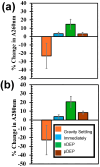The Pre-Polarization and Concentration of Cells near Micro-Electrodes Using AC Electric Fields Enhances the Electrical Cell Lysis in a Sessile Drop
- PMID: 39852073
- PMCID: PMC11763957
- DOI: 10.3390/bios15010022
The Pre-Polarization and Concentration of Cells near Micro-Electrodes Using AC Electric Fields Enhances the Electrical Cell Lysis in a Sessile Drop
Abstract
Cell lysis is the starting step of many biomedical assays. Electric field-based cell lysis is widely used in many applications, including point-of-care (POC) applications, because it provides an easy one-step solution. Many electric field-based lysis methods utilize micro-electrodes to apply short electric pulses across cells. Unfortunately, these cell lysis devices produce relatively low cell lysis efficiency as electric fields do not reach a significant portion of cells in the sample. Additionally, the utility of syringe pumps for flow cells in and out of the microfluidics channel causes cell loss and low throughput cell lysis. To address these critical issues, we suspended the cells in a sessile drop and concentrated on the electrodes. We used low-frequency AC electric fields (1 Vpp, 0-100 kHz) to drive the cells effectively towards electrodes and lysed using a short pulse of 10 V. A post-lysis analysis was performed using a hemocytometer, UV-vis spectroscopy, and fluorescence imaging. The results show that the pre-electric polarization of cells, prior to applying short electrical pulses, enhances the cell lysis efficiency. Additionally, the application of AC electric fields to concentrate cells on the electrodes reduces the assay time to about 4 min. In this study, we demonstrated that low-frequency AC electric fields can be used to pre-polarize and concentrate cells near micro-electrodes and improve cell lysis efficiency. Due to the simplicity and rapid cell lysis, this method may be suitable for POC assay development.
Keywords: cell lysis; dielectrophoresis and AC electroosmosis; electric fields; induced transmembrane potential.
Conflict of interest statement
The authors declare no conflicts of interest.
Figures





Similar articles
-
All electronic approach for high-throughput cell trapping and lysis with electrical impedance monitoring.Biosens Bioelectron. 2014 Apr 15;54:462-7. doi: 10.1016/j.bios.2013.11.031. Epub 2013 Nov 18. Biosens Bioelectron. 2014. PMID: 24315878
-
Solution pH change in non-uniform alternating current electric fields at frequencies above the electrode charging frequency.Biomicrofluidics. 2014 Dec 19;8(6):064126. doi: 10.1063/1.4904059. eCollection 2014 Nov. Biomicrofluidics. 2014. PMID: 25553200 Free PMC article.
-
Concentration-Polarization Electroosmosis near Insulating Constrictions within Microfluidic Channels.Anal Chem. 2021 Nov 9;93(44):14667-14674. doi: 10.1021/acs.analchem.1c02849. Epub 2021 Oct 27. Anal Chem. 2021. PMID: 34704741 Free PMC article.
-
Electric field-induced effects on neuronal cell biology accompanying dielectrophoretic trapping.Adv Anat Embryol Cell Biol. 2003;173:III-IX, 1-77. doi: 10.1007/978-3-642-55469-8. Adv Anat Embryol Cell Biol. 2003. PMID: 12901336 Review.
-
Electrode-based AC electrokinetics of proteins: A mini-review.Bioelectrochemistry. 2018 Apr;120:76-82. doi: 10.1016/j.bioelechem.2017.11.010. Epub 2017 Nov 23. Bioelectrochemistry. 2018. PMID: 29182911 Review.
References
MeSH terms
Grants and funding
LinkOut - more resources
Full Text Sources

